Steamy Java 2012 Blog
Diesel Tour Part 2
Updated 9 August
Steamy Java 2012
DVD (Details Later) |
Fellow participant John Browning is blogging this trip and his own prelude. You can follow him here. Also blogging is tour leader Bernd Seiler. His blog is here.
The continuation of Bernd's Diesel Tour is planned to provide:
22 July - Visit to the sugar mill Semboro. In 2011 three
of the small 0-4-0-Schöma diesels did the work on
temporary tracks while eleven of the Japanese locos did the line work.
In the depot we’ll find quite a
number of dumped steam locos while two fireless O&K locomotives are
hustling and bustling in the cane
yard. In the large field network there are usually two or three trains
starting off to the sugar mill before
sunset. At one of the numerous level crossings we’ll photograph
these trains. Hotel in Jember.
We arrived around 7:30 to find that during Ramadan the office staff don't need to come until 8 am. However, it's a Sunday as well so by 8:20 we still didn't have anyone to do the paperwork and take the money. We finally got our permission and visited the fireless locos, a field line to the east, another to the north east, the dual gauge bridge, the depot and the river bridge to the west. I'll let the pictures do the talking with a brief commentary to help.
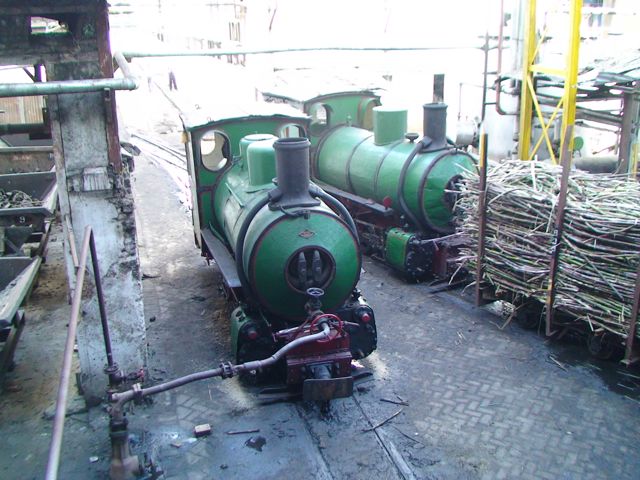
Both fireless seen from a new elevated position, No. 2 on the left and No. 3 on the right.
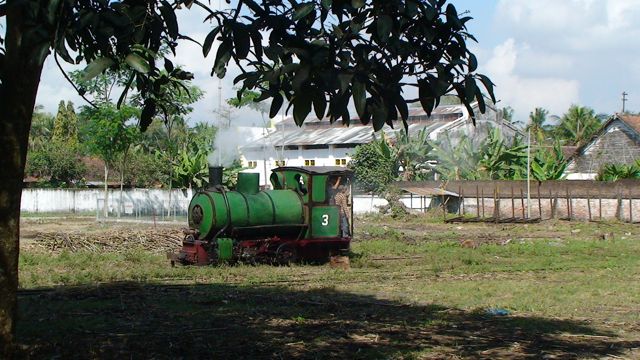
No. 3 returns to the lines of loaded cane wagons to start the next cycle of feeding the mill. Having brought the cane forward, it will swap with No. 2 and recharge while No. 2 pulls the loads to the mill train. A diesel takes away the empties to release the fireless to return for another rake of loaded cane wagons.
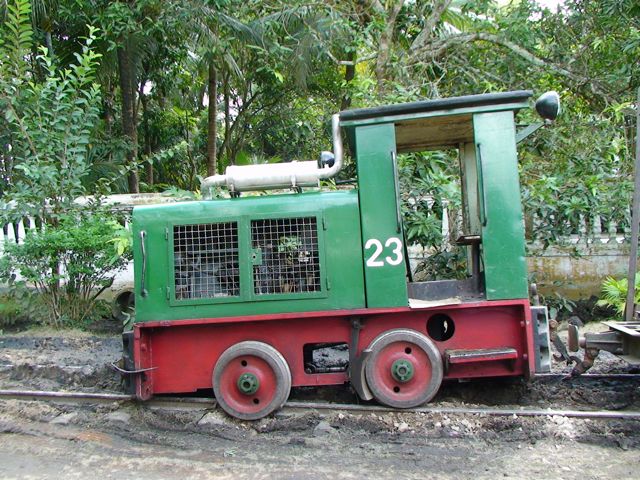
No. 23 derailed on track that has been spread by road trucks. In the afternoon, it was back in action.
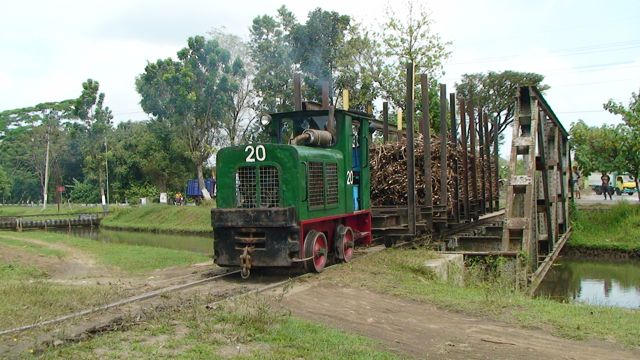
No. 20 does a run past across the former dual gauge bridge leading to the state railway.
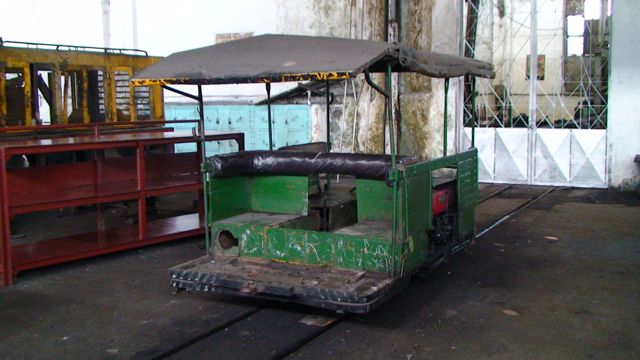
After lunch, this inspection trolley in the depot caught my eye. A real relic of colonial times? The (replacement) engine is from Kubota.
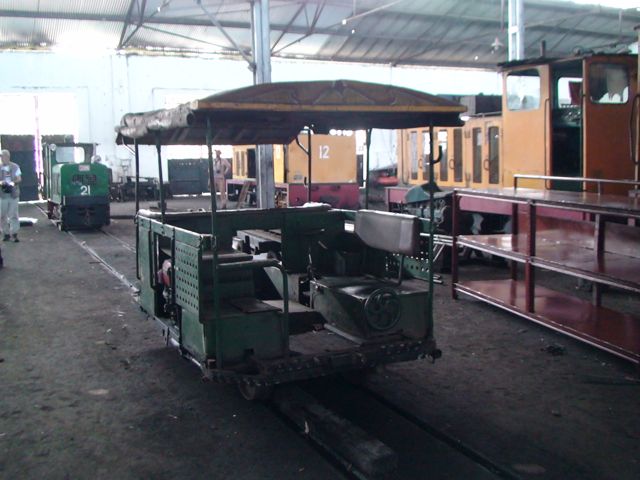
Rear view of the same trolley showing the driver's position and controls on the right.
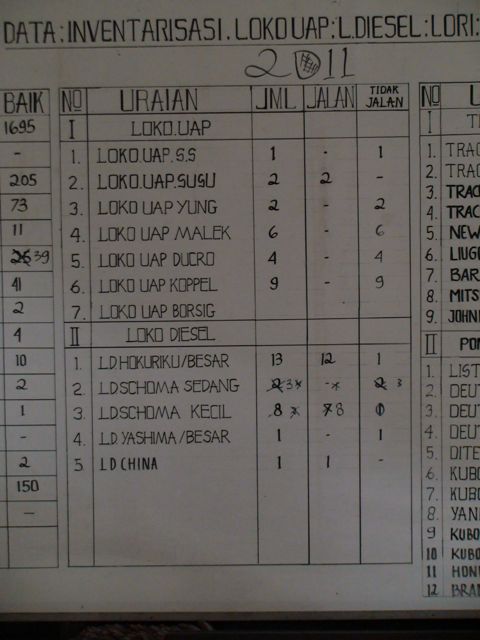
The steam and diesel stock list for 2011. Note the only working steam are the 2 fireless (Loko Susu) and the Chinese loco is included in the diesel fleet. Why was there a line for Borsig steam locos?
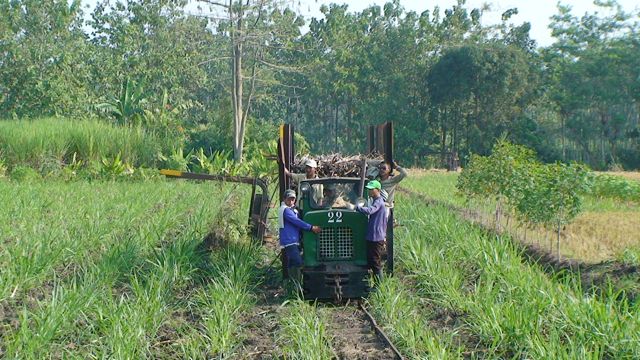
Our first mission in the afternoon was to find a small loco working on the temporary track. Here No. 20 brings 2 cane lori to the main line on temporary track.
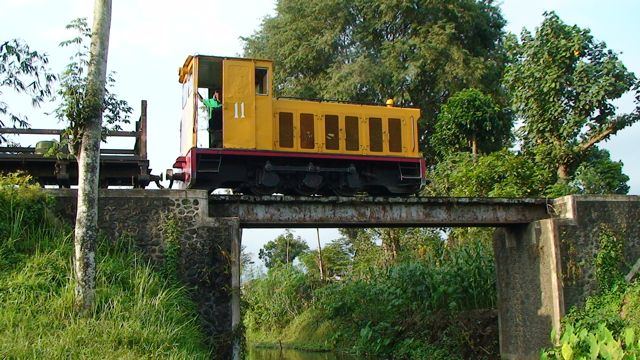
Our second mission was to get out to the big bridge and find some trains. We saw 3 locos going off to the fields - No. 11 has crossed the big bridge and is now on the canal bridge.
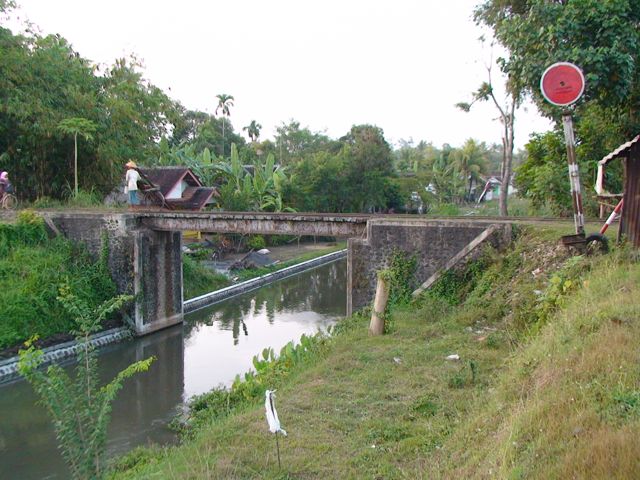
However, our attempts to find a daylight cane train in the afternoon failed and this shot of the canal bridge shows what we missed.
23 July - On our way to Situbondo we’ll pay Prajekan
a brief visit. We expect to see two Schöma and three
Japanese diesels. In addition we’ll see three larger 0-10-0 Luttermöller
steam locomotives dumped in the
depot. In the afternoon we’ll visit the sugar mill Panji. On 600
mm tracks they haul long and heavy trains.
Japanese diesel locomotives predominate on the line service, but they
also have Schömas and Diemas.
Besides this, the whole steam fleet is still there, in the depot at Panji.
Hotel in Situbondo.
At Prajakan, molasses are taken from the factory to a large holding tank in a train hauled by loco No. 3 with 3 wasp-stripe tank wagons that shuttles back and forth around 12 times every 24 hours. In addition, 3 0-10-0 locos and an 0-8-0T are stored in the shed and two additional diesels 2 and 4 were seen in the cane yard where a footbridge across the cane tracks provides a good view. Two 0-8-0T steam locos and diesels 1, 5 and 6 were sent to Asembagus some years ago. The field lines are disused.
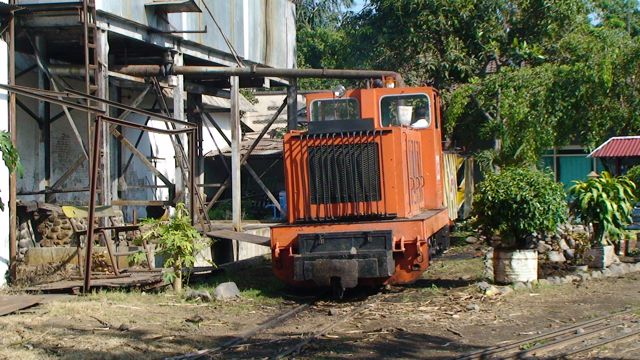
Loco No. 3 waits for molasses loading to start at the factory.
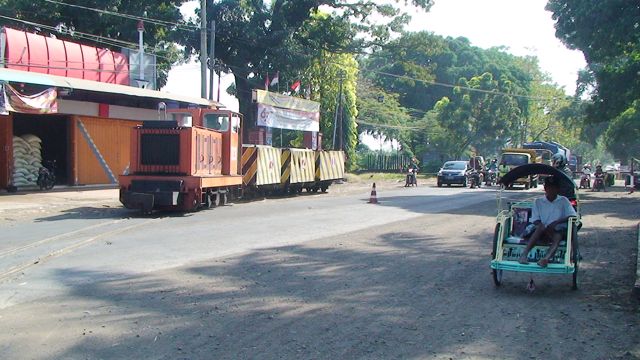
The molasses train reverses to the big tank.
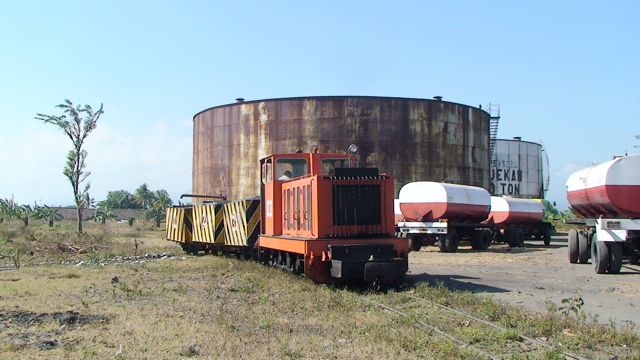
The train at the big tank. Total length of run less than 0.5 km. The road tankers will take the molasses away.
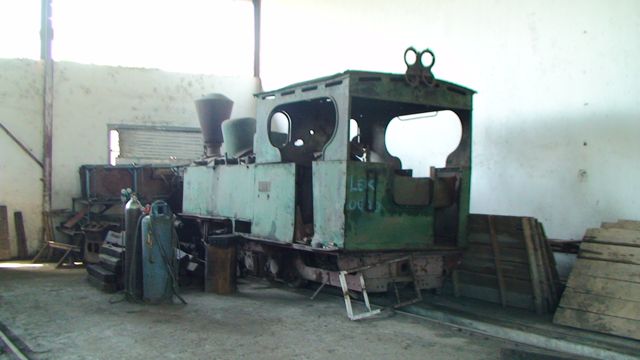
Loco No. 9 in the shed.
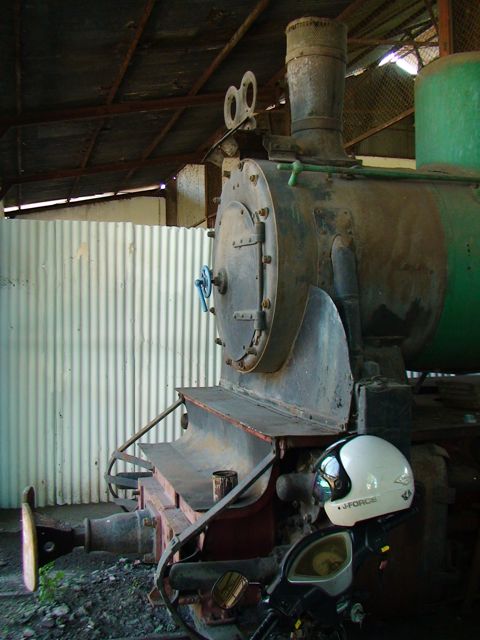
Close up of the front of No. 8. The spectacle plate for lights is similar to mainline locos on the state railway in the past. Powerful locos were required because of the hill nature of the area.
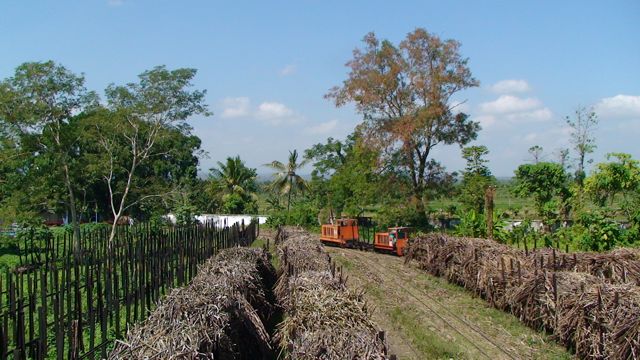
View from the footbridge over the cane storage lines looking south with locos 2 (closest) and 4.
In the afternoon, we visited Panji. First the depot and yard and then the only field line at the moment which happens to be to a cane field about 5 km along the busy Surabaya - Banyuwangi (for Bali) road. Traffic varies from heavy to light so you can be lucky with shots from the other side of the road. The train left around 4 pm and arrived back at the mill in daylight (just).
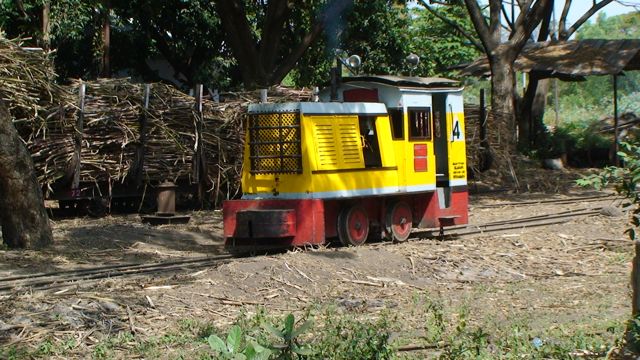
The locos are now in an attractive two tone livery.
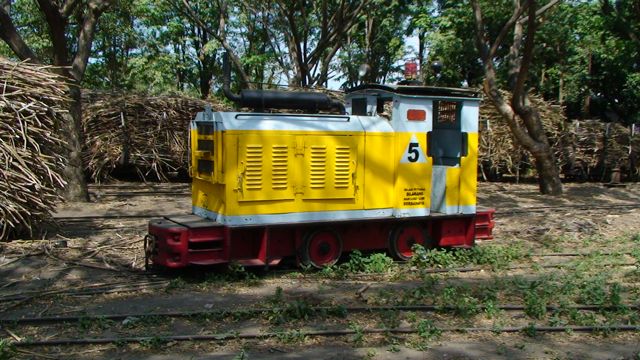
Small locos move cane the final distance to the mill. Rollers are in place for cable operation but we didn't see this in operation. The small diesels were also inactive (shift change) and the mill was busy accepting cane direct from road trucks.
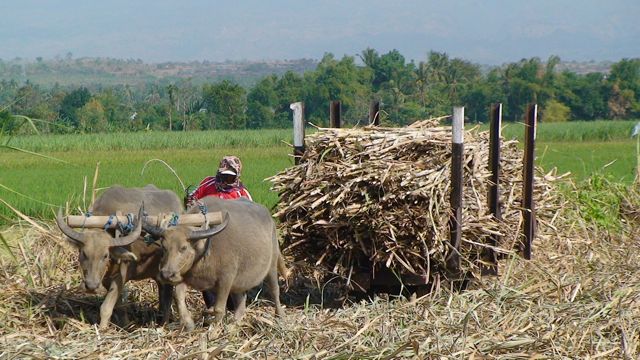
At the cane field, water buffalo in pairs and sometimes a set of four, were hauling cane out of the field to the permanent track across the main road.
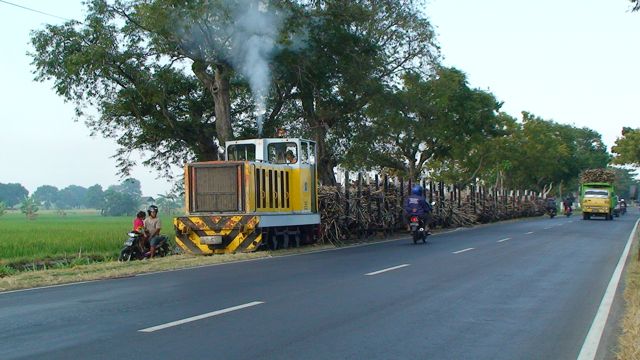
Diesel No. 10 departing for the mill.
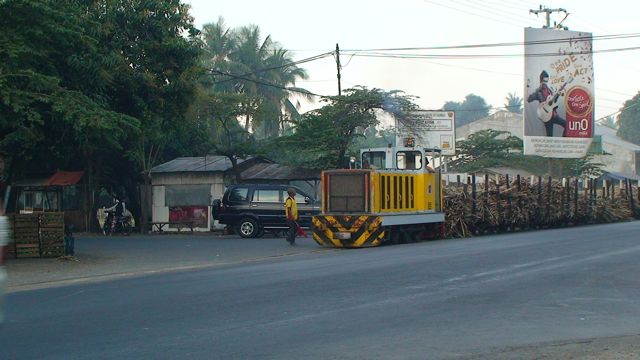
In a lull in traffic, the train crosses a side road with the remains of a disused field line heading north behind the vehicle.
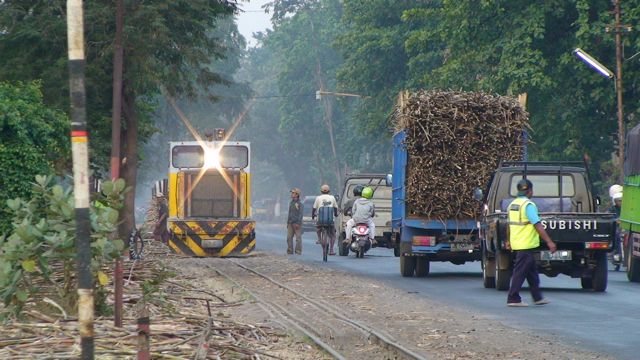
At the weighbridge, the loco ran round its train before propelling it in the mill.
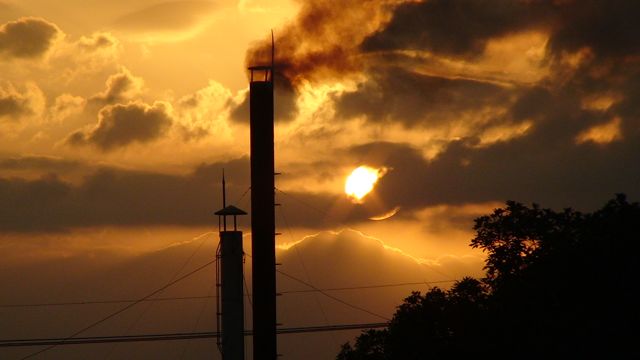
This was the smoky sunset shot close to the mill.
24 July - Full day visit to the sugar mill of Wringinanom.
Wringinanom still operates a field network on which the
smaller diesels (three Diema and one Schöma) are used to bring the
empty trains into the fields while
the four heavier Japanese locomotives pick up the loaded trains to bring
them back to the mill. One
plinthed and two dumped steam locomotives can be seen here as well, not
to forget the stationary steam
engines inside the mill! Hotel in Situbondo.
We left the hotel at 6:45 so we were at Wringinanom well before 7. Permission came relatively swiftly and we drove round to the back entrance and the depot. In the yard 5 diesels were parked up waiting the day's duties. In the shed, steam locos No. 6 and 7 slumber on. No. 6 still wears the Mickey Mouse paint scheme from when it last moved (in 2001?). Trains to the fields didn't leave until after 8:30. One long train with large Keio diesel No. 4 to the north and two trains with small diesels to the south. A third train to the south was cancelled as there were not enough cane cutters in the fields. The late departure and the cancelled train could be the Ramadan effect.
In the afternoon, after lunch and wi-fi in Pasir Putih, we went first to Olean to see diesel No. 1 working the siding down to the field at Gelung because they had decided in the last week that the track wasn't suitable for the steam loco. The diesel bought out 2 loads for steam No. 1 and then a load for itself and headed back to the mill. Steam loco No. 1 started off with its train (its injector problems of last week seemed solved) but derailed a lori at a similar location to where I had to leave it last week. Another partial success. We headed back to see the diesel action at Wringinanom - it is a diesel tour - but it was tough to leave a steam train in the fields before sunset. At Wringinanom we saw No. 3 and No. 6 bring a train in from the south before the sun set.
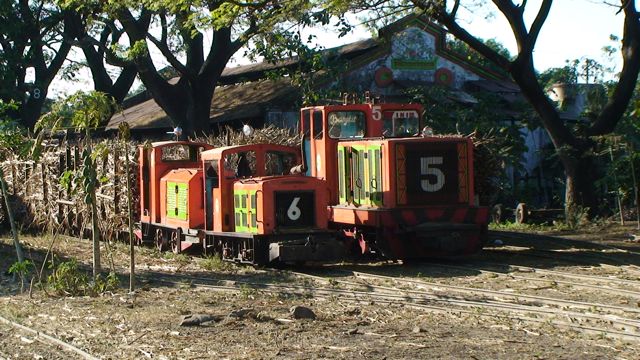
Three diesels in their latest paint scheme with the steam shed in the background.
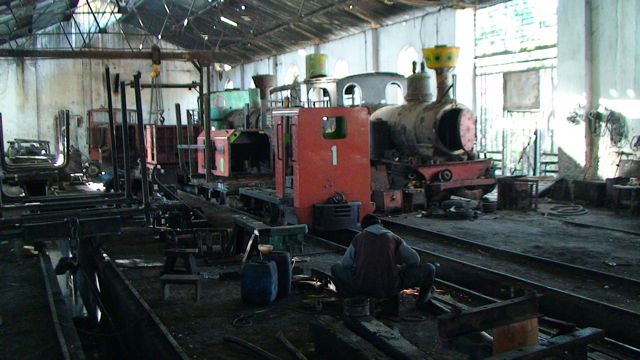
No. 6 (front) and No. 7 remain parked in the shed.
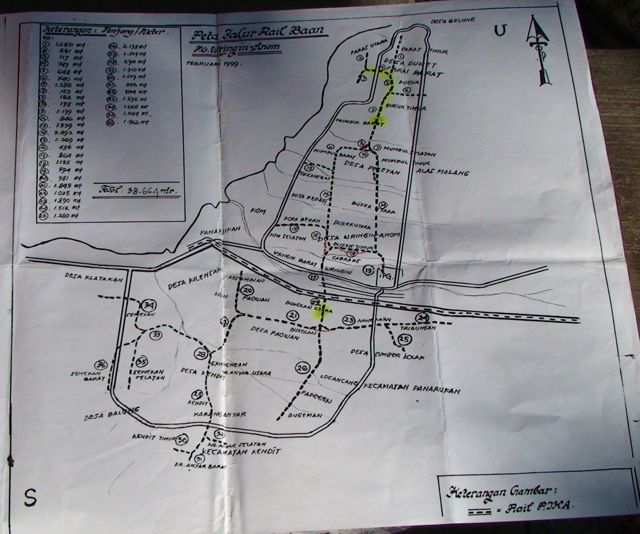
Map of the field lines. Cutting was going on at the places highlighted in yellow north and south.
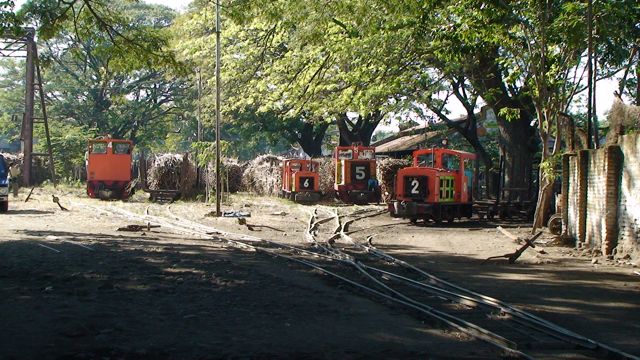
The line-up of 5 locos before any went to the fields. No. 3 was at the other end of the yard.
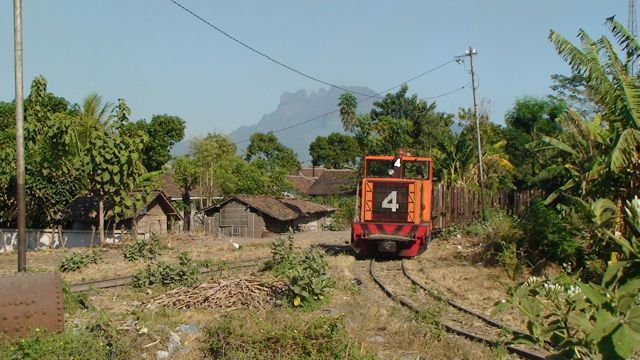
After shunting empty lori, No. 4 comes round the triangle ready to depart for the fields via the weighbridge.
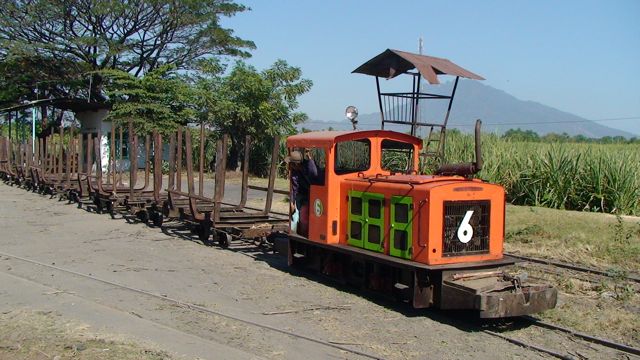
No. 6 near the weighbridge with Mt Ringgit behind.
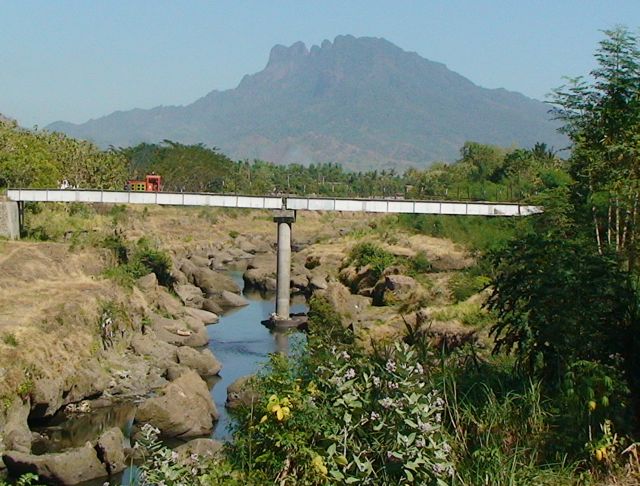
Small loco with empty lori on the new bridge over the river heading to the southern fields.
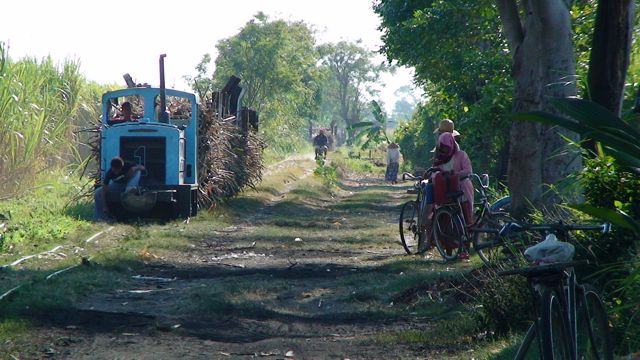
Olean diesel No. 1 at Gelung brings out a partial load for the steam loco.
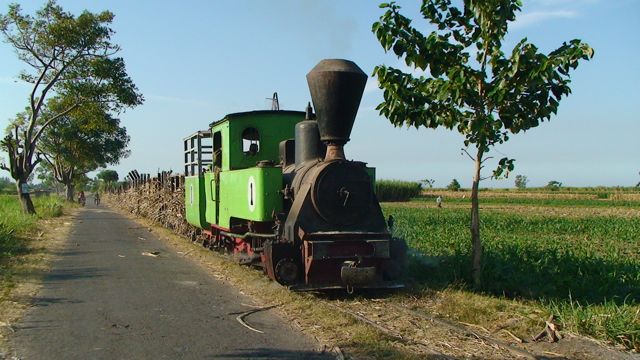
No. 1 underway with its train. It didn't get far before a lori derailed.
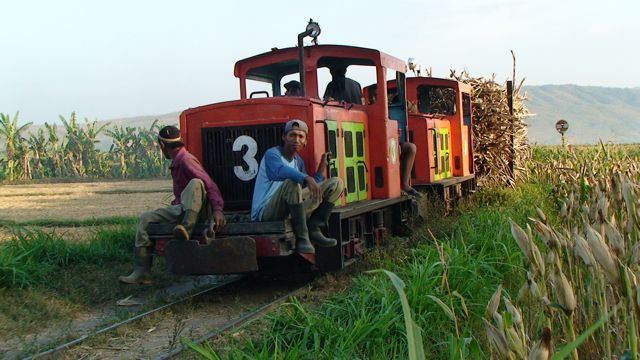
No. 3 and No. 6 at Wringinanom bring in a train past the disc signal for the state railway (disused) on the south line.
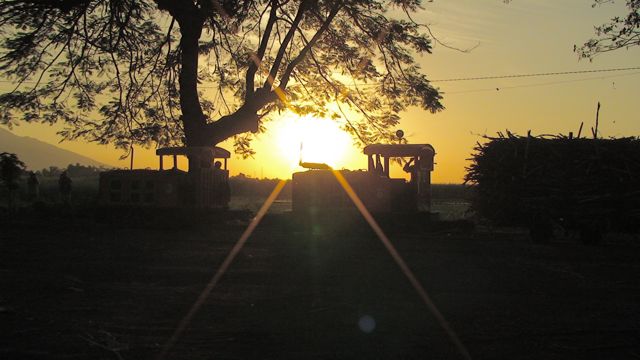
The best of my still against the light at Wringinanom at sunset.
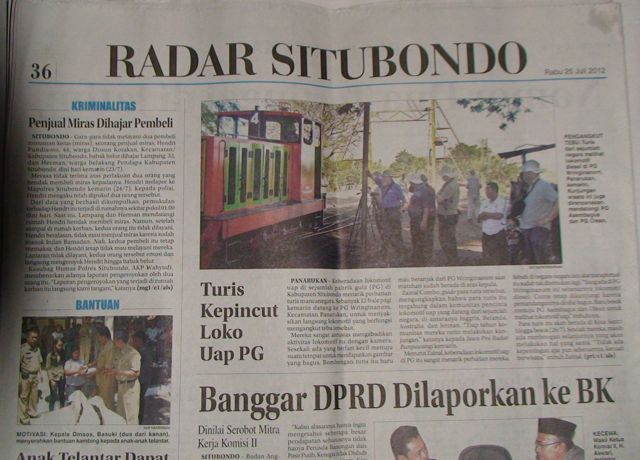
We made page 36 of the local newspaper next day. Visible in the photo are me, Richard, Chris, back of Hans, Combo and John Browning at the back entrance to Wringinanom Mill.
25 July - In the morning we’ll go to the sugar mill
Asembagus. The mill still uses one or two steam locomotives
for the field work, but enthusiasts often overlook that there are a couple
of interesting diesels that work
field trains as well. In 2011 they used six diesels, not a single one
looks like another ... There are several
photogenic field lines and often loaded trains which are running during
daylight. In the evening we’ll
continue to our hotel in Bondowoso.
We arrived at Asembagus about 7:30. The bagged sugar train was only working internally today and not going to the warehouse at the port. So, instead we rode the O&K diesel No. 6 with a train of 65 empty lori to the north east. After dropping the lori, we continued light engine and rather than continue towards the forest, we turned north towards the sea getting within 1 km or so of the beach. The loco collected a loaded train and after putting in the chains, headed back to the mill. We caught it twice before going to lunch. On the shed, steam loco No. 10 was being made ready for our charter in 2 days' time. No. 9 was the only other steam loco remaining in the shed. All others have been removed. In the afternoon, the new managers after shift change felt that what we had done in the morning for free (riding a loco to the fields) should be paid for. So we declined and headed off to the junction on the line to the north and saw a cane train come past around 4:30. However, clouds got in the way and it wasn't the greatest afternoon with only the 2 big Keio diesels out in the fields (as far as we know). News about the demands for $5 per person to ride the loco (payable to the despatcher's office - no need to go to the administration office!) came at 2:30, too late to head over to Olean for the afternoon trains.
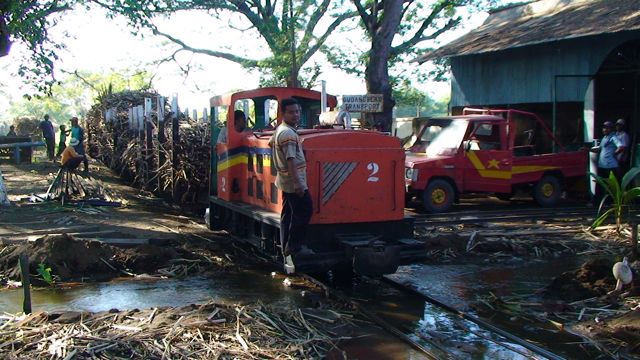
The mill yard still has a stream running through it just like 2 years ago.
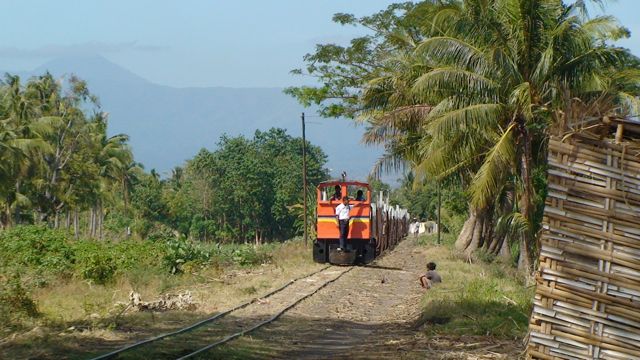
No. 6 heads for the field with 65 empty lori with Kawa Ijen volcano in the background.
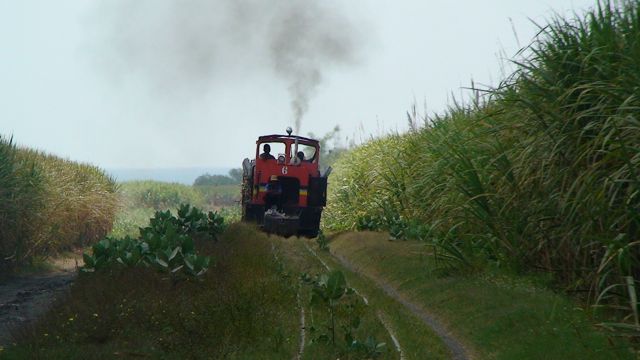
No. 6 heads back to the mill with a short train of cane. Unfortunately, we found a cloud for this shot.
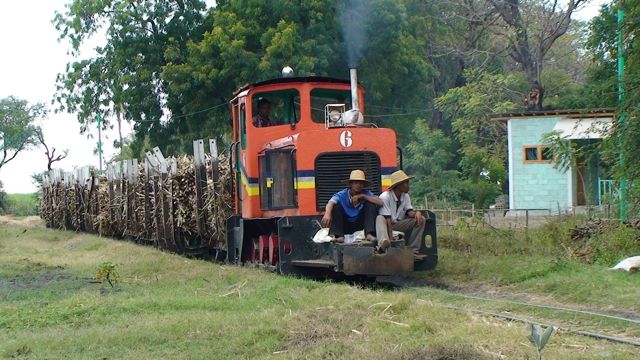
The cloud persisted so we headed for lunch in Asembagus village.
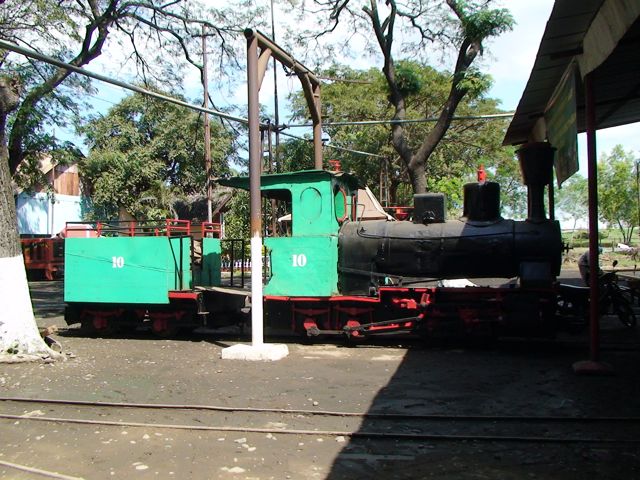
Loco No. 10 awaits its call to action on 27 July.
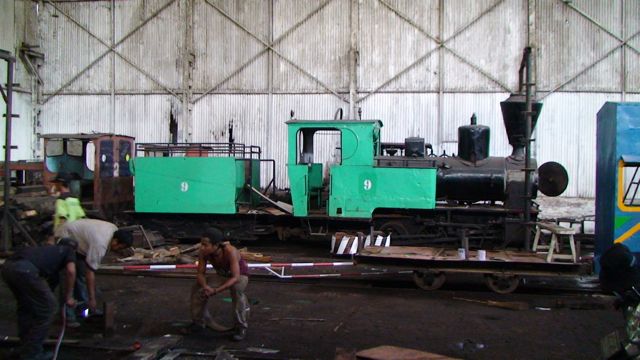
No. 9 is the other working steam loco. This is former No. 11, I believe.
26 July - Before Sunrise we’ll drive and walk up the
crater of volcano Kawah Ijen. From the bottom of the caldera
of the active volcano sulphur steam raises into the sky – and sulphur
collectors carry heavy loads (about 70kg) of sulphur over the edge of
the crater to sell it on the market. They do an incredible heavy, dirty
and dangerous job, only by seeing it can you believe it. When the visibility
is good we’ll have amazing
views over the eastern volcanoes of Java. In the late morning we’ll
go down and drive back to our hotel
in Situbondo.
Breakfast at 4 and on the road by 4:30 but it was still close to 8 am when we arrived at the parking place for Kawah Ijen. It's a steep 3 km (1 hour)walk to the crater but the views are worth it. With that, we ended the diesel tour and headed back to Situbondo to collect the new participants for the steam tour.
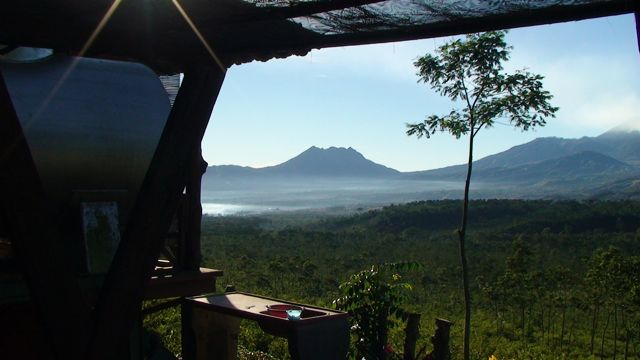
View of the volcanoes at the entrance to the coffee plantation.
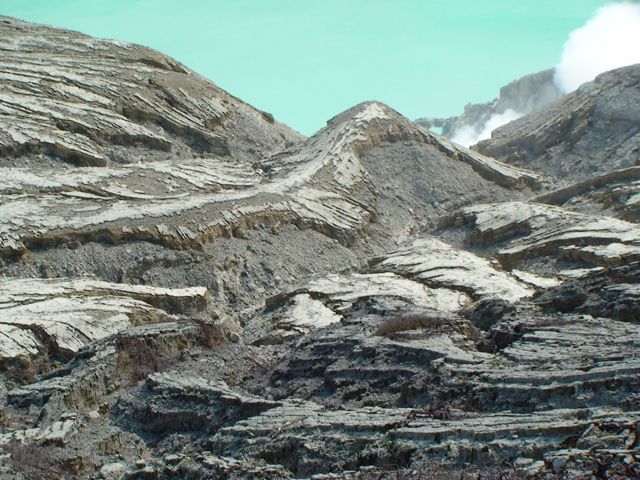
Eroded volcanic rocks in the crater.
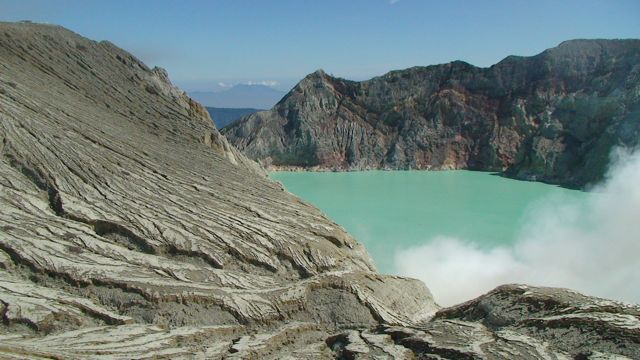
View of the sulphuric acid lake in the crater.
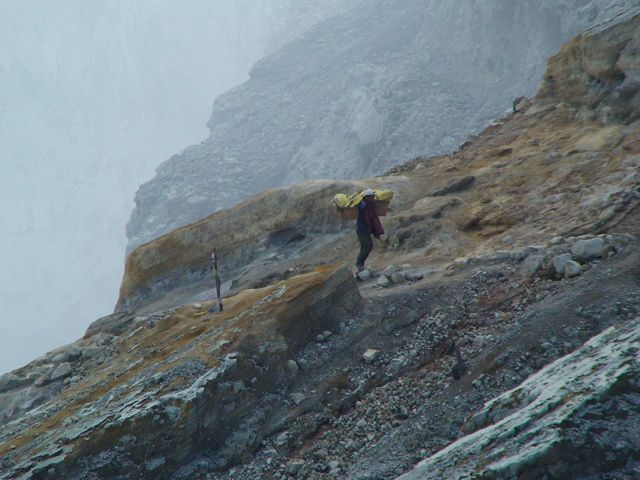
A sulphur carrier brings 70-90 kgs out of the crater.
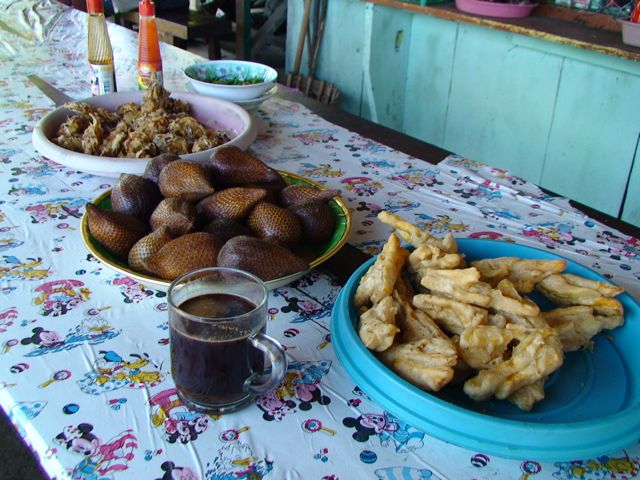
Well-earned refreshment when I got back to the car park.
The Diesel Tour ends on the 26th and the Steam Tour starts after lunch on 26 July. To read about that, click here for the Steam Tour Part 1.
You can contact me at john@linesiding.co.uk